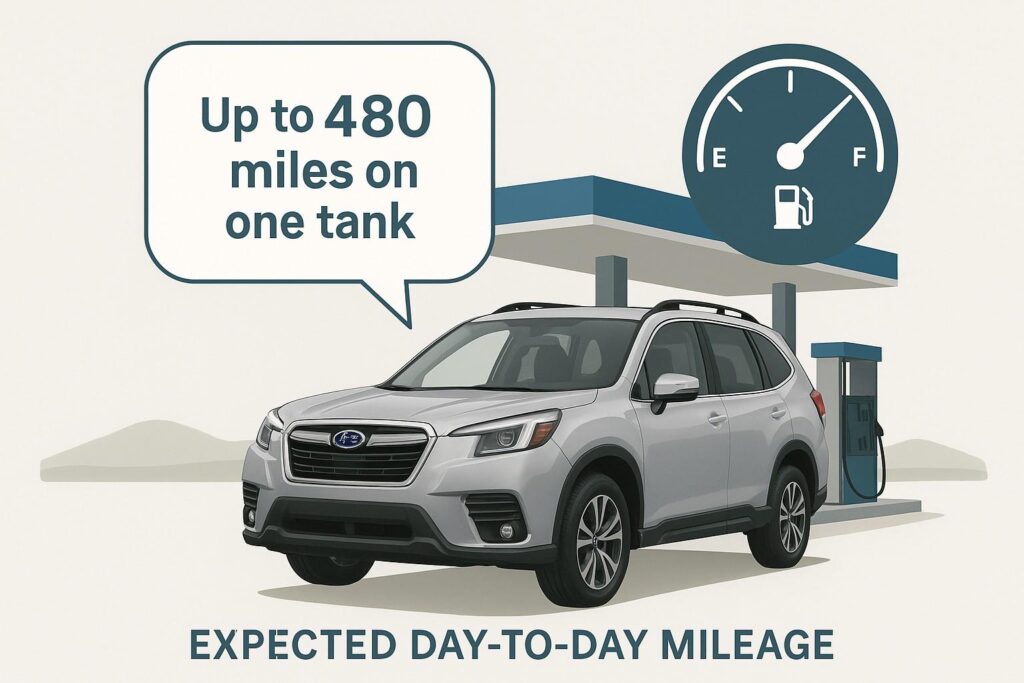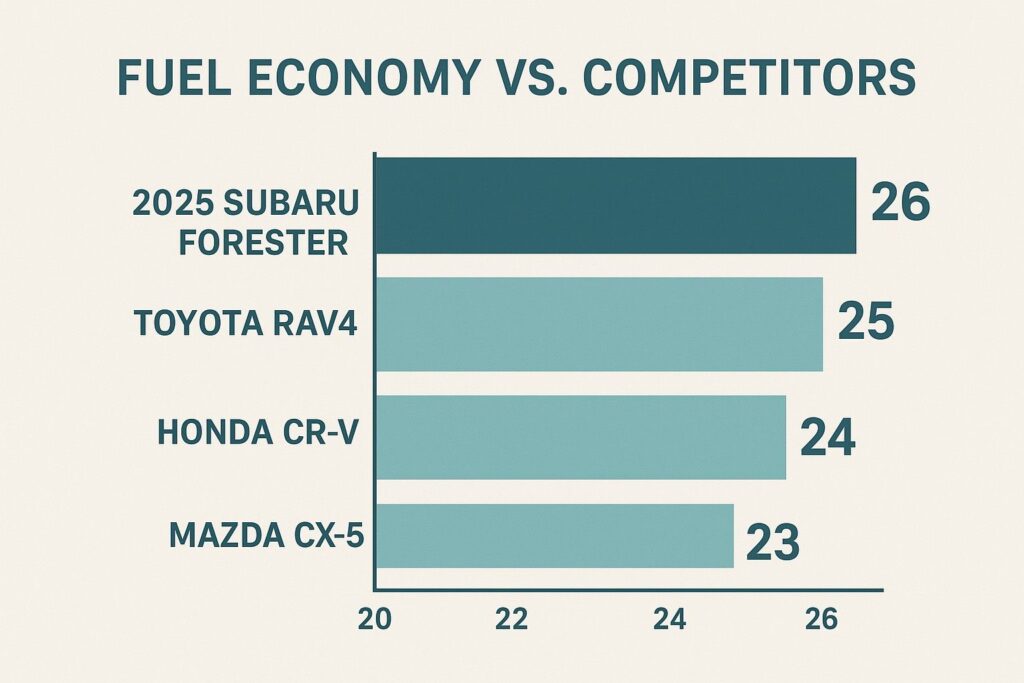2025 Subaru Forester Fuel Economy Guide

Most people don’t think much about fuel economy until gas prices rise and fill-ups start cutting into the budget. That’s when questions about whether your SUV is saving money—or wasting it—become real. If you’ve been searching for the 2025 Subaru Forester fuel economy, you’re likely wondering if this SUV delivers the right balance of efficiency, practicality, and long-term value.
In this guide, we’ll break down everything you need to know about the Forester’s MPG. You’ll see ratings by trim level, city vs. highway performance, and how it compares to rival SUVs. We’ll also cover driving range on a full tank, long-term fuel costs, and simple habits to stretch every mile. By the end, you’ll know if the 2025 Subaru Forester is truly as efficient as Subaru claims.
2025 Subaru Forester MPG Overview
Subaru keeps things straightforward here. Every Forester, no matter the trim, uses the same 2.5L SUBARU BOXER® engine paired with Subaru’s Symmetrical All-Wheel Drive. That setup gives you year-round traction without forcing you to sacrifice much at the pump.
According to EPA fuel economy ratings, most trims sit at 26 MPG in the city and 33 MPG on the highway, averaging about 29 MPG. Sport and Touring versions dip just slightly lower, while the Wilderness—built tougher for off-road trails—lands at 25/28 MPG.
How Many Miles Per Gallon Does the Subaru Forester Get?
The numbers don’t swing wildly across trims, which is good news. If you pick the Base, Premium, or Limited, you’ll enjoy the best mileage. The Sport and Touring trims shave off about one mile per gallon, and the Wilderness comes in last, but it’s built for different priorities.
So if maximum savings at the pump matter most, the base trims are your best bet. But if adventure calls, the Wilderness gives you confidence off-road while still being reasonable on gas compared to other rugged SUVs.
2025 Subaru Forester MPG by Trim
Here’s a clear look at how each trim performs on paper:
📊 2025 Subaru Forester MPG by Trim
| Trim | City MPG | Hwy MPG | Combined MPG |
|---|---|---|---|
| Base | 26 | 33 | 29 |
| Premium | 26 | 33 | 29 |
| Limited | 26 | 33 | 29 |
| Sport | 25 | 32 | 28 |
| Touring | 25 | 32 | 28 |
| Wilderness | 25 | 28 | 26 |
You’ll notice Subaru managed to keep things fairly consistent across the lineup. That means your decision usually comes down to features and lifestyle needs, not fuel savings.
City vs. Highway MPG
Like most SUVs, the Forester shines on the highway. City driving comes in around 25–26 MPG, while highway cruising can stretch up to 33 MPG.
This balance makes it practical for everyday errands but also comfortable for longer road trips. If your routine mixes stop-and-go with weekend getaways, the Forester does a nice job of blending both.
EPA Estimates vs. Real-World Experience
EPA figures give you a ballpark, but let’s be honest—we all want to know what it’s like in real life. Most Forester owners report their numbers land close to official ratings. On flat roads in good weather, you’ll likely hit EPA expectations.
That said, hauling gear, climbing hills, or driving aggressively can pull MPG down by a couple of points. Winter conditions and more frequent AWD use also cut into efficiency a bit. Still, compared with rivals, the Forester tends to hold steady.
Expected Day-to-Day Mileage
With a 16.6-gallon tank, you can expect between 430 and 480 miles per fill-up depending on the trim and how you drive. That kind of range makes the car practical for daily commutes and longer trips without constant stops for gas.

For most drivers, that means refueling only once a week—or even less—if your routine is light. It offers peace of mind knowing you can cover plenty of ground before needing to visit the pump again.
Fuel Economy vs. Competitors
Comparisons matter when you’re shopping. Here’s where the Forester lands against other popular small SUVs:
- Toyota RAV4: 27 city / 35 highway MPG
- Honda CR-V: 28 city / 34 highway MPG
- Mazda CX-5: 26 city / 31 highway MPG

So no, the Forester isn’t the absolute champ, but it’s close. And the standard AWD adds a level of safety and control many drivers feel is worth the tiny trade-off.
How Weather and Terrain Affect MPG
Driving in the real world means dealing with weather and road conditions. Cold winters, mountain passes, and rough trails tend to lower MPG by 2–4 points. The Wilderness trim, with its chunky tires and raised suspension, naturally dips more when pushed hard off-road.
On the flip side, highway travel in calm weather often beats the official numbers. I’ve seen Forester drivers report topping 30 MPG on long road trips without even trying.
Long-Term Ownership and 5-Year Fuel Costs
Over the years, those MPG differences add up. Based on 15,000 miles per year, here’s what you’re looking at:
- Base, Premium, Limited (29 MPG): around $8,100 in fuel over five years
- Sport, Touring (28 MPG): about $8,400
- Wilderness (26 MPG): close to $9,000
It is not massive year to year but in the long run the additional stops at the gas tank do count-particularly when your yearly mileage is approaching record levels.
Key Ways Subaru Improves Fuel Efficiency
Subaru didn’t stumble into these numbers by accident. The 2.5L SUBARU BOXER® engine is tuned for balance, giving you 180 horsepower and 178 lb-ft of torque without being thirsty. The Lineartronic® CVT keeps the engine in its efficiency zone, and SI-DRIVE® lets you adjust performance modes depending on your needs.
Even subtle details like aerodynamic shaping and AWD efficiency help keep MPG competitive, proving Subaru thought carefully about long-term ownership costs.
Driving Habits & Tips to Maximize MPG
Getting good mileage isn’t just about the car—it’s about how you drive it. Here are a few habits that make a difference:
- Use SI-DRIVE® Intelligent Mode for normal daily driving
- Keep your tires properly inflated
- Accelerate smoothly and avoid hard braking
- Stay current with maintenance—fresh oil and a healthy CVT really help
Little adjustments like these can easily bump your real-world MPG up by a couple points.
Conclusion
The 2025 Subaru Forester has a mid point between capability and efficiency at the end of the day. The average of most trims is nearly 30 MPG which is quite remarkable considering normal AWD. The Wilderness trim burns a little more gas, yet it provides off-road assurance that few competitors can provide.
When you desire an SUV that can navigate the day to day journeys, weekend drivers and other weather conditions without putting you through the torture at the gas pump, the Forester is one vehicle that is worth considering.
Discover expert car tips, towing guides, and vehicle insights at CarFact.online.
FAQ: 2025 Subaru Forester Fuel Economy
1. How many miles per gallon does a 2025 Subaru Forester get?
Most trims of the 2025 Subaru Forester receive 26 city / 33 highway MPG (29 combined). The Sport and Touring have a slight reduced height and the Wilderness has an average of 25/28 MPG.
2. What gas should I put in my 2025 Subaru Forester?
You should use regular unleaded 87-octane gasoline. Premium fuel isn’t required, keeping running costs affordable.
3. Are Subaru Foresters cheap to insure?
Yes, the Subaru Forester is generally cheaper to insure thanks to its strong safety ratings, reliability, and standard AWD.
4. Do Subaru Foresters hold their value?
Foresters hold their value well compared to other small SUVs. Their safety, durability, and all-weather capability keep resale prices strong.
5. What are the weaknesses of a Subaru Forester?
The low horsepower, a little less than the MPG with the Wilderness trim, and some road noise are its weak points. However, the limitations are insignificant compared to its fuel efficiency, safety and value.
Have questions about the 2025 Subaru Forester Fuel Economy? Contact us—we’re here to help you get the right answers.
